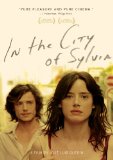| Reviews & Columns |
|
Reviews DVD TV on DVD Blu-ray 4K UHD International DVDs In Theaters Reviews by Studio Video Games Features Collector Series DVDs Easter Egg Database Interviews DVD Talk Radio Feature Articles Columns Anime Talk DVD Savant Horror DVDs The M.O.D. Squad Art House HD Talk Silent DVD
|
DVD Talk Forum |
|
|
| Resources |
|
DVD Price Search Customer Service #'s RCE Info Links |
|
Columns
|
|
|
In the City of Sylvia
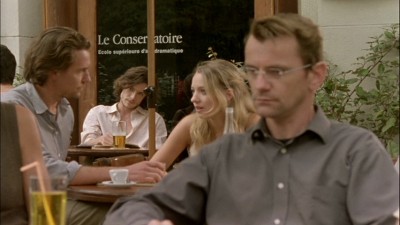
What if those hypnotic sequences in Vertigo where Jimmy Stewart pursues, spies on, and obsesses over Kim Novak, following her through what seem to be all the locales of San Francisco, were in themselves the entire extent of the film, stretched out to feature length and slowed down so that each shot allowed us a lingering awareness of the surrounding city, and glimpses of all the lives being lived around the mysterious woman and her fanatical shadow? That is something like what José Luis Guerin does in his awesomely accomplished In the City of Sylvia, in which the obsessive search of a young artist (Xavier Lafitte) for a woman he met six years ago--whose face he cannot even be certain he remembers exactly--becomes a languorous, captivating trip down the cinematic rabbit hole, a buffet of visual pleasures and emotional perceptions that quietly but irresistibly entices and gratifies.
It is actually not until late in the film that we are really given the details of this young man's quest. As the film opens, we come upon him with no introduction; he is alert, sketch pad in hand, scanning the veritable sea of female faces that surrounds him at an outdoor café. The camera lets us gaze along with him, enjoying the sight of people out in the summer light and breeze, bits of each individual's or couple's life playing out; all this at the same time we wonder just what, exactly, he's looking for. He begins to sketch one girl, then abandons that and moves on to another. Is an enigmatic line he writes on another page--"Dans la ville de Sylvia" ("In the city of Sylvia") a clue as to what he's up to?
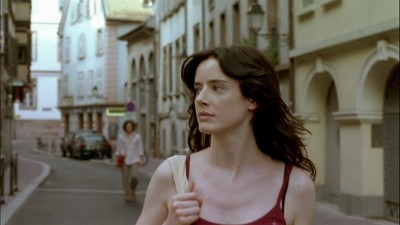
When he finally, suddenly gets up to run after a particular (and particularly appealing) young woman, the subsequent pursuit through the modernized streets and ancient alleyways of Strasbourg--one of the most picturesque cities in France, though this film is much more than a postcard-picture travelogue--is imbued with a compelling mystery. Who is she, exactly? Is he even sure? He calls out "Sylvia," a name that he seems fairly certain of, but she appears not to recognize it as her own. The hunt is full of digressions, moments when he loses her and has his attention diverted by something else, or when we lose both of them momentarily and see some other bit of Strasbourg life going on, or broader, magnificent wider-shot compositions encompassing the city's life in general.
During this young man's three-day stay in the city, we are always aware of his general objective, and further clarifying clues about specifically what he's doing and why emerge as he continues his search, interacting with the chosen girl and others. But we also become familiar, through many very brief but richly suggestive moments, with certain residents of Strasbourg whose lives are concurrent with his obsessive movements and observations: a waitress, an unhappy couple, a cranky panhandler, a comically insistent street vendor.
There is something incredibly moving about Guerin's generosity--his acknowledgment of other lives always going on around us, everyone with their own legitimate concerns--and his ability, via an exquisitely sensitive, meticulous attention to light, sound, setting, mise-en-scène, and facial expression, to extend that generosity to what we see on the screen. There is very little reliance upon verbal exposition; that kind of clunky convention would weigh down this fleet, graceful film. "Show, don't tell" is obeyed pretty stringently here, and we don't want to turn our eyes away from what Guerin is so adeptly showing us.
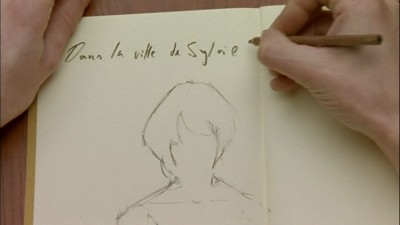
THE DVD:
The 1.66:1 anamorphic transfer of In the City of Sylvia does justice to the film's impeccably composed imagery; the colors are all vivid, and the many outdoor, sunlit scenes are captured with all the glory of their light and shadowplay preserved. The one setback is that Cinema Guild appears to have been working with a print that is ever so slightly the worse for wear, with occasional, microsecond-long instances of celluloid surface flaws that might have been cleaned up with a slightly more thorough restoration or new print for the DVD--luxuries that may not be within the reach of Cinema Guild, a small, independent distributor with a history of bringing us some truly essential cinema (Jia Zhangke's 24 City and Agnès Varda's The Beaches of Agnes, for two examples). As it is, the tiny, momentary flashing "spots" are almost unnoticeable, and the experience is no different than seeing the film on a cinema screen in its second or third week of release, after it's been run through the projector a number of times.
Sound:There is very little dialogue in In the City of Sylvia, but sound is an absolutely crucial element, whether what we're hearing is Strasbourg's public-transit trams approaching and departing, chatter overheard in the street, the scratching of the young man's pencil and his sketchbook's pages fluttering in the wind, or the film's carefully conceived occurrences of diegetic music. Guerin's use of heightened, deceptively simple naturalistic sound rivals that of the great Robert Bresson. The sound on the DVD does not fail his meticulous sound design; its Dolby digital 2.0 mix is excellent, full and clear, with no deficiencies or flaws whatsoever.
Extras:Cinema Guild has included an immensely valuable extra in the form of a feature-length photo montage, Some Photos in the City of Sylvia (2007), which was made and released as a sort of prelude or "visual screenplay" to In the City of Sylvia. With the aid of sub- and intertitles, Guerin's photos from journeys he has made to Strasbourg and Florence are edited together to form a rhythmic slideshow story in a style that recalls Chris Marker's La Jetée. The story here is looser, more autobiographical, and more expansive than In the City of Sylvia, and though it is distinct in many ways from its successor and an impressive work of cinema in its own right, this piece makes a wonderful complement to the main film, detailing some of the inspirations for its themes of time, place, and memory, as well as offering a brief dip into its foundational (if not obviously specified) literary origins, those idealized, elusive feminine characters--Lotte in Goethe's Young Werther, Beatrice in Dante's Inferno, Petrarch's Laura--who are European literature's most iconic symbols of haunting memory and obsessive longing. The graffiti everywhere in the Strasbourg of In the City of Sylvia that reads "Laure, je t'aime" ("Laura, I love you") certainly does not require knowledge of the Petrarch reference to attain its evocativeness, but having it revealed is fascinating regardless. An additional 7-minute short in the same style, "In the City of Lotte," does for Frankfurt (Goethe's birthplace) what Some Photos... did for Strasbourg and Florence.
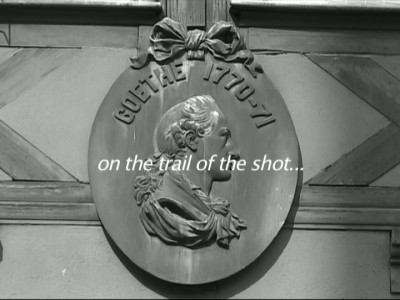
Additionally, there are three silent black and white "vignettes" from 2007--"Women Waiting for the Tram," "Woman Waiting for the Tram," and "Train Strausbourg-Paris"--primarily consisting of Guerin's earlier, preliminary attempts at filming the elements of some scenes that appear in In the City of Sylvia.
Finally, the film's trailer is included, as is a small booklet featuring "Our Sylvias--and Guerin's," an essay/appreciation by critical elder statesman Jonathan Rosenbaum on both In the City of Sylvia and Some Photos in the City of Sylvia.
FINAL THOUGHTS:In the City of Sylvia is a riveting, beautiful, and profound exploration of the basic but not-so-simple, eternal themes of romantic attraction, fixation, longing, and memory, and it proves once again that the cinema is a perfect medium in which to depict those parts of the human experience that are more fully expressed through sound and vision than with mere words. Everyone should see it, but it is mandatory viewing for anyone who has been impressed by the composed strain of contemporary Continental filmmaking--Revanche, Caché, Dogtooth, the films of Pedro Costa, etc.--that signifies its confidence through well-honed, elegant visual composition and measured, quiet pacing. The film is a rare cinematic treasure of the highest order, and Highly Recommended.
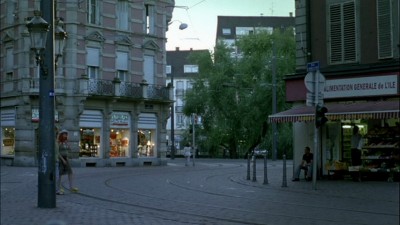
|
| Popular Reviews |
| Sponsored Links |
|
|
| Sponsored Links |
|
|
| Release List | Reviews | Shop | Newsletter | Forum | DVD Giveaways | Blu-Ray | Advertise |
|
Copyright 2024 DVDTalk.com All Rights Reserved. Legal Info, Privacy Policy, Terms of Use,
Manage Preferences,
Your Privacy Choices | |||||||









